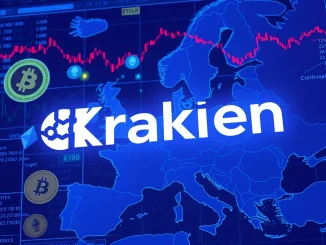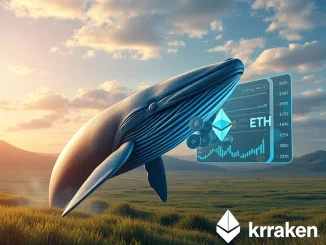
Get ready for a seismic shift in the crypto landscape! The European Union’s evolving regulatory environment is prompting major crypto players to rethink their strategies, especially when it comes to stablecoins. Forget business as usual – exchanges like Kraken and Crypto.com are actively exploring launching their own stablecoins. Why? Because new EU rules are making it tough to keep certain popular tokens, like Tether’s USDT, listed. Let’s dive into this exciting development and see what it means for you and the future of crypto in Europe.
Navigating EU Regulations and the Stablecoin Shift
The winds of change are blowing strong from the EU! New regulations are requiring stablecoin issuers to hold a specific e-money license to operate within the European Union. This is a game-changer. For crypto exchanges, it means that simply listing any stablecoin they fancy is no longer an option. Tokens that don’t meet these licensing requirements are facing the delisting axe. Think of it as the EU setting stricter standards for the digital asset world, aiming for greater consumer protection and market stability. This regulatory push is the key driver behind why we’re seeing exchanges like Kraken and Crypto.com proactively exploring their own stablecoin ventures.
Key takeaways about EU regulations and stablecoins:
- Licensing is now mandatory: Issuers of stablecoins in the EU must secure an e-money license. No license, no operation.
- Delisting pressure: Exchanges are facing pressure to delist stablecoins that don’t comply with EU regulations.
- Innovation driver: These regulations are pushing exchanges to innovate and seek compliant stablecoin solutions.
- Market reshaping: The regulatory shift is poised to reshape the European stablecoin market.
Kraken and Crypto.com Leading the Charge in Stablecoin Innovation
Two major players, Kraken and Crypto.com, are stepping up to the plate and signaling their intentions to launch their own stablecoins. According to a Bloomberg report, Kraken is aiming to launch a USD-pegged stablecoin through its Irish entity. This strategic move allows Kraken to operate within the EU regulatory framework while still offering users access to a dollar-backed digital currency. Crypto.com isn’t far behind, targeting a Q3 2025 launch for their own stablecoin. Both exchanges are clearly recognizing the need to adapt and provide compliant alternatives as the regulatory landscape evolves. This proactive approach underscores their commitment to the European market and their users within it.
| Exchange | Stablecoin Plan | Target Launch | Key Details |
|---|---|---|---|
| Kraken | USD-pegged stablecoin | TBD | Operating via Ireland unit for EU compliance |
| Crypto.com | Stablecoin | Q3 2025 | Seeking to expand stablecoin offerings |
The Impact of EU Regulations on Crypto Exchanges and USDT Dominance
What does this regulatory shake-up mean for the broader crypto market, and specifically for the dominance of stablecoins like USDT? Tether’s USDT, while being the largest stablecoin by market capitalization, has faced increasing regulatory scrutiny globally. The EU regulations add another layer of pressure. Interestingly, USDT’s market share has already seen a dip, falling from a commanding 70% to around 63%. This suggests a gradual diversification and potentially an opening for new, compliant stablecoins to gain traction. As exchanges actively seek and launch regulated stablecoin options, we could witness a more fragmented and potentially healthier stablecoin ecosystem in Europe. The regulations, while initially causing some disruption, could ultimately foster greater trust and stability in the long run.
USDT Market Share Trend:
- Previous Dominance: USDT held around 70% market share in the stablecoin space.
- Recent Decline: Market share has decreased to approximately 63%.
- Opportunity for Alternatives: This decline creates space for new, regulated stablecoins to emerge.
Why are Crypto Exchanges Exploring Stablecoins? Benefits and Opportunities
Why are crypto exchanges so keen on launching their own stablecoins? It boils down to a mix of strategic advantages and market opportunities. For crypto exchanges, offering their own stablecoin can provide:
- Regulatory Compliance: Crucially, it allows them to operate within the EU’s regulatory framework, ensuring continued access to the European market.
- Revenue Generation: Stablecoin issuance can generate revenue through various mechanisms, including transaction fees and potential interest earned on reserves.
- Enhanced User Experience: Having a native stablecoin can streamline trading pairs, reduce dependency on third-party tokens, and potentially offer faster and cheaper transactions for users within their ecosystem.
- Brand Building: Launching a successful stablecoin can enhance an exchange’s brand reputation and solidify its position as an innovator in the crypto space.
- Market Share Expansion: By offering a compliant and attractive stablecoin, exchanges can attract new users and potentially capture a larger share of the European crypto market.
Challenges and Considerations for New Stablecoin Launches
While the prospect of launching stablecoins is enticing, crypto exchanges face several challenges and important considerations. It’s not as simple as just creating a token. Here are some key hurdles:
- Regulatory Hurdles: Navigating the EU’s regulatory landscape and obtaining the necessary e-money license is a complex and potentially lengthy process.
- Reserve Management: Ensuring the stablecoin is truly pegged to its fiat currency (like USD) requires robust reserve management and transparent auditing.
- Trust and Adoption: Building trust in a new stablecoin takes time and effort. Users need to be confident in its stability, security, and the issuing exchange’s credibility.
- Competition: The stablecoin market is already competitive. New entrants need to differentiate themselves and offer compelling value propositions to attract users.
- Operational Complexity: Managing a stablecoin involves significant operational overhead, including compliance, security, and ongoing maintenance.
The Future of Stablecoins in the EU and Beyond
The move by crypto exchanges like Kraken and Crypto.com to explore stablecoin launches marks a significant turning point for the European crypto market. EU regulations are acting as a catalyst for innovation and compliance, potentially leading to a more mature and regulated stablecoin ecosystem. While challenges remain, the long-term outlook is positive. These developments could pave the way for greater mainstream adoption of stablecoins in Europe and potentially set a precedent for regulatory frameworks in other jurisdictions. Keep an eye on this space – the stablecoin revolution in Europe is just getting started!
In Summary
The EU’s regulatory shift is compelling crypto exchanges to adapt and innovate in the stablecoin arena. Kraken and Crypto.com’s exploration of new stablecoin launches highlights this proactive response. While challenges exist, the move towards regulated stablecoins promises a more stable and trustworthy crypto environment in Europe, potentially reshaping the market and opening up exciting new opportunities. The evolution of stablecoins in the EU is a story worth watching closely!



